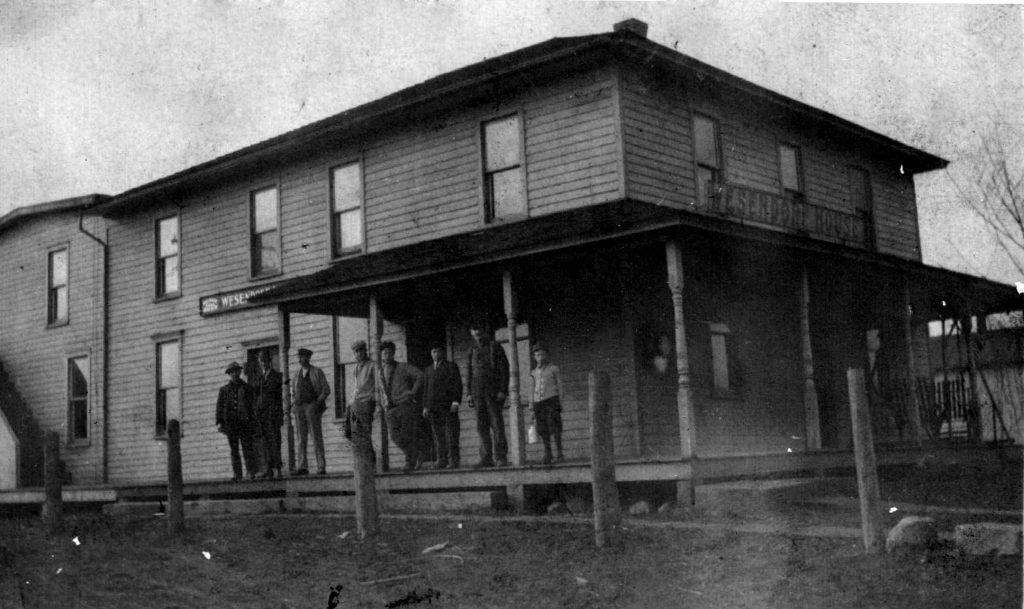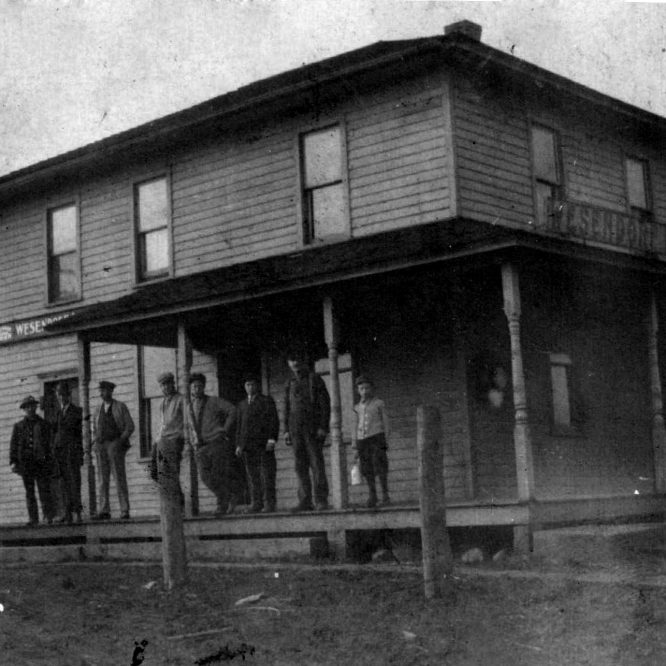Vol. 5, No. 28
This photograph shows the Wesendorf House that operated at Fancher. Although this photograph is not labeled, it is presumed that the image was taken in the early 1900s and one of the men standing on the porch is the proprietor, John Wesendorf, Jr. It appears these men have stepped outside from the establishment to pose for this photo as a young boy stands with them holding what appears to be a milk can. The building functioned as a saloon and hotel for a number of years in the early half of the 19th century.
John Lewis Wesendorf, a native of Germany, immigrated to Hamlin, New York with his family in the early 1870s. The Wesendorfs were part of the large settlement of Germans at that location, many whom arrived between 1865 and 1880. At some point in the late 1880s, the Wesendorfs relocated to the Town of Murray where John Wesendorf, Sr. took up farming. As indicated by his petition for naturalization in 1891 and confirmed by the 1892 New York Census, John Wesendorf, Jr. was employed as a stone dresser by a local quarry. The petition, filed on March 12, 1891, includes signatures from Thomas Tuite, a fellow quarry laborer, and Thomas F. Reed, the owner of a quarry at Hulberton.
The exact date Wesendorf purchased this structure is unknown, but by 1905 John Wesendorf, Jr. appears on the New York Census for that year as the proprietor of this hotel located on Fancher Road. At the time this photograph was taken, Route 31 did not contain the bend in the road now known as the “Fancher Curve.” This hotel was situated on a parcel of land situated on the southwest corner of the Million Dollar Highway and Fancher Road, the two roads forming a right-angle intersection which still exists today. In 1926, William Gallagher of Medina was contracted to add the bend and remove the right-angle intersection. As a result, this building was relocated to the east side of the road where it remains today.
Living nearby was Deputy Sheriff Walter Tice, who in 1913 accused Wesendorf of selling him and several other customers bottles of beer. The accusation came during a time when Murray was considered a “dry town” and Wesendorf was charged with an excise law violation. Tice testified that he, John Howell, George Owens, and Roscoe Minckley purchased two bottles of beer each from Wesendorf. The defense showed that the barroom was closed and locked on the day Tice claimed he purchased the alcohol and asserted that Wesendorf was being framed. During a cross-examination, Tice admitted that a local temperance organization offered a $50 reward for evidence leading to the conviction of excise law violations. The final nail in the coffin came when District Attorney John Knickerbocker recalled Tice to the stand, believing that Tice incorrectly stated the date in which he purchased the booze. Tice doubled down, upholding his previous testimony that he was sold the beer on July 3rd; Owens and Minckley both swore that neither was with Tice on that day. The jury deliberated for one-half hour before delivering a verdict of not guilty.
Wesendorf died January 14, 1929, and was buried at Mount Albion Cemetery. Following his death, the building closed until 1940 when Michael and Ruth Fiorito purchased the building, repaired it, and reopened it as “Hotel Fancher.”


